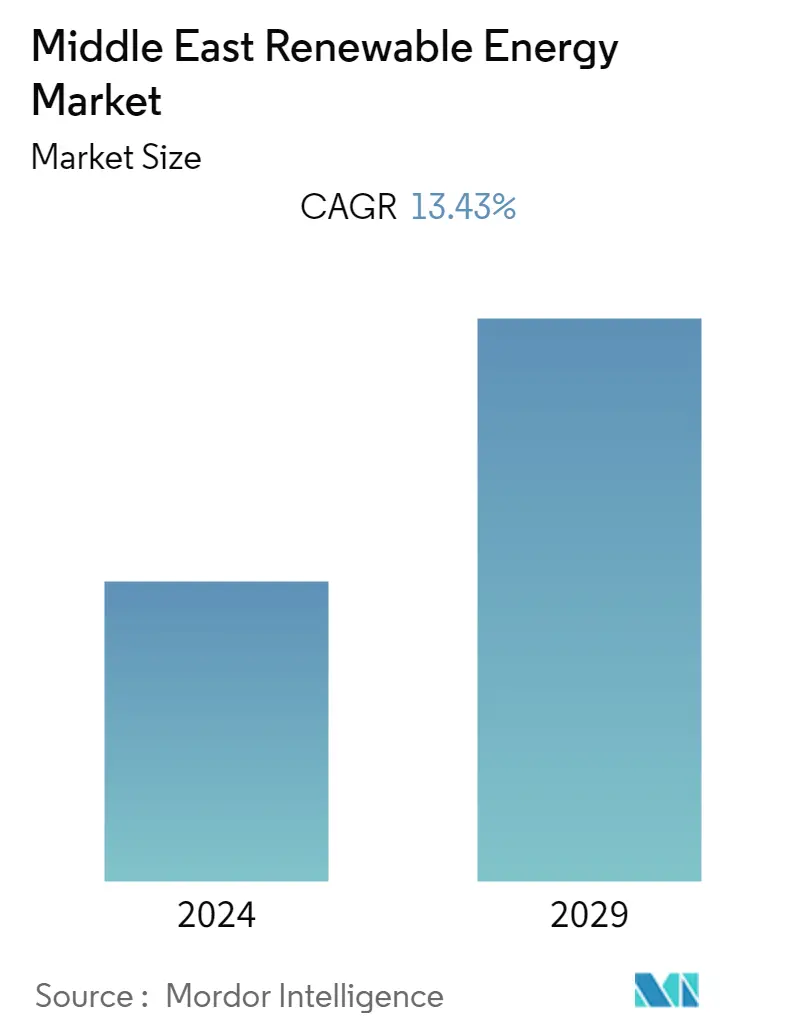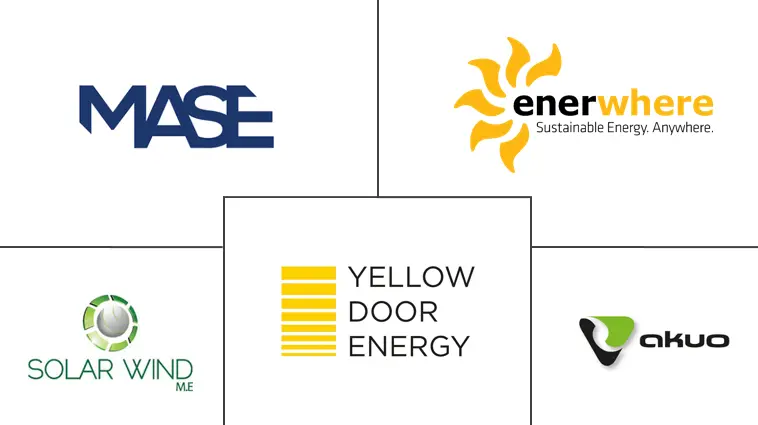Market Size of Middle East Renewable Energy Industry

| Study Period | 2020 - 2029 |
| Base Year For Estimation | 2023 |
| Forecast Data Period | 2024 - 2029 |
| Historical Data Period | 2020 - 2022 |
| CAGR | 13.43 % |
| Market Concentration | Medium |
Major Players
*Disclaimer: Major Players sorted in no particular order |
Middle East Renewable Energy Market Analysis
The Middle Eastern renewable energy market is expected to register a CAGR of around 13.43% during the forecast period. The market has reached pre-pandemic levels though it was negatively impacted by COVID-19 in 2020.
- Over the medium term, factors such as various governments' plans to diversify the energy mix and increase investments in renewable energy are expected to drive the market.
- On the other hand, the increasing penetration of natural gas for power generation and its lower price are expected to restrain the growth of the market during the forecast period.
- Nevertheless, renewable power is an intermittent energy source. Therefore, the storage of electricity is essential to maintain the constant power distribution of generated renewable power. Thus, the increasing integration of renewable energy and energy storage systems is expected to create future market opportunities.
- The United Arab Emirates (UAE) is expected to witness significant growth in the Middle Eastern renewable energy market during the forecast period, owing to upcoming projects and government targets.
Middle East Renewable Energy Industry Segmentation
Renewable energy emanates from natural sources or processes replenished naturally, including sources like wind, sunlight, etc. It creates lower emissions than non-renewable resources.
The renewable energy market is segmented by type (hydro, solar, wind, other types) and geography (United Arab Emirates (UAE), Saudi Arabia, Oman, Iran, Israel, Jordon, Rest of Middle East). The report also covers the market size and forecasts for the renewable energy market across the major countries. For each segment, the market sizing and forecasts have been done based on installed capacity in gigawatts.
| By Type | |
| Hydro | |
| Solar | |
| Wind | |
| Other Types |
| By Geography | |
| United Arab Emirates (UAE) | |
| Saudi Arabia | |
| Oman | |
| Iran | |
| Israel | |
| Jordan | |
| Rest of Middle East |
Middle East Renewable Energy Market Size Summary
The Middle Eastern renewable energy market is poised for substantial growth, driven by government initiatives to diversify energy sources and increase investments in renewables. Despite the challenges posed by the COVID-19 pandemic, the market has rebounded to pre-pandemic levels. The region's focus on solar energy, supported by projects and government targets, is expected to play a crucial role in achieving renewable energy goals. The integration of renewable energy with energy storage systems presents further opportunities for market expansion. However, the growing use of natural gas for power generation, due to its cost-effectiveness, poses a challenge to the market's growth trajectory.
The United Arab Emirates (UAE) is at the forefront of this renewable energy transition, with significant investments and projects aimed at boosting solar energy capacity. The country's strategic initiatives, such as the Dubai Green Fund and the Shams Dubai initiative, are facilitating the adoption of solar power. The UAE's geographical advantage, coupled with declining solar module costs, makes solar energy a viable option to meet its energy needs. The UAE Energy Strategy 2050 aims to significantly increase the share of clean energy in the national energy mix, aligning with global climate commitments. This strategic focus is expected to drive significant growth in the Middle Eastern renewable energy market, with the UAE leading the charge.
Middle East Renewable Energy Market Size - Table of Contents
-
1. MARKET OVERVIEW
-
1.1 Introduction
-
1.2 Renewable Energy Mix, 2020
-
1.3 Installed Capacity and Forecast in GW, till 2027
-
1.4 Recent Trends and Developments
-
1.5 Government Policies and Regulations
-
1.6 Market Dynamics
-
1.6.1 Drivers
-
1.6.2 Restraints
-
-
1.7 Supply Chain Analysis
-
1.8 Porter's Five Forces Analysis
-
1.8.1 Bargaining Power of Suppliers
-
1.8.2 Bargaining Power of Consumers
-
1.8.3 Threat of New Entrants
-
1.8.4 Threat of Substitutes Products and Services
-
1.8.5 Intensity of Competitive Rivalry
-
-
-
2. MARKET SEGMENTATION
-
2.1 By Type
-
2.1.1 Hydro
-
2.1.2 Solar
-
2.1.3 Wind
-
2.1.4 Other Types
-
-
2.2 By Geography
-
2.2.1 United Arab Emirates (UAE)
-
2.2.2 Saudi Arabia
-
2.2.3 Oman
-
2.2.4 Iran
-
2.2.5 Israel
-
2.2.6 Jordan
-
2.2.7 Rest of Middle East
-
-
Middle East Renewable Energy Market Size FAQs
What is the current Middle East Renewable Energy Market size?
The Middle East Renewable Energy Market is projected to register a CAGR of 13.43% during the forecast period (2024-2029)
Who are the key players in Middle East Renewable Energy Market?
Enerwhere Sustainable Energy DMCC , Solarwind M.E. , Akuo Energy SAS , Yellow Door Energy and MASE are the major companies operating in the Middle East Renewable Energy Market.

